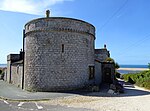Ferry Bridge, Dorset
Geography of Weymouth, DorsetIsle of PortlandJurassic Coast

Ferry Bridge is at the beginning of the causeway to the Isle of Portland, Dorset, England, and is the point at which the Fleet lagoon joins Portland Harbour. It is situated several hundred metres south of Portland's boundary with the village of Wyke Regis, Weymouth. To the west of Ferry Bridge is the start of The Fleet, which is an internationally important nature reserve that extends to Abbotsbury Swannery, while to the east is Portland Harbour. Along the harbour side is Smallmouth Beach. The only road between Portland and the Mainland (the A354) passes across Ferry Bridge.
Excerpt from the Wikipedia article Ferry Bridge, Dorset (License: CC BY-SA 3.0, Authors, Images).Ferry Bridge, Dorset
Ferry Bridge,
Geographical coordinates (GPS) Address Nearby Places Show on map
Geographical coordinates (GPS)
| Latitude | Longitude |
|---|---|
| N 50.583 ° | E -2.4712 ° |
Address
Ferry Bridge (Portland Beach Road)
Ferry Bridge
DT4 9JZ , Portland
England, United Kingdom
Open on Google Maps








